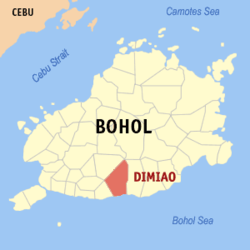This article needs additional citations for verification .(October 2013) |
Dimiao | |
|---|---|
| Municipality of Dimiao | |
 National Road in Dimiao | |
 Map of Bohol with Dimiao highlighted | |
Location within the Philippines | |
| Coordinates: 9°37′N124°10′E / 9.62°N 124.17°E | |
| Country | Philippines |
| Region | Central Visayas |
| Province | Bohol |
| District | 3rd district |
| Founded | 22 January 1769 |
| Barangays | 35 (see Barangays) |
| Government | |
| • Type | Sangguniang Bayan |
| • Mayor | Randolph L. Ang |
| • Vice Mayor | Noel M. Hamlag |
| • Representative | Kristine Alexie B. Tutor |
| • Municipal Council | Members |
| • Electorate | 11,129 voters (2025) |
| Area | |
• Total | 135.75 km2 (52.41 sq mi) |
| Elevation | 68 m (223 ft) |
| Highest elevation | 494 m (1,621 ft) |
| Lowest elevation | 0 m (0 ft) |
| Population (2024 census) [4] | |
• Total | 14,894 |
| • Density | 110/km2 (280/sq mi) |
| • Households | 3,457 |
| Economy | |
| • Income class | 4th municipal income class |
| • Poverty incidence | 22.62 |
| • Revenue | ₱ 138 million (2022) |
| • Assets | ₱ 358.7 million (2022) |
| • Expenditure | ₱ 107 million (2022) |
| • Liabilities | ₱ 910.4 million (2022) |
| Service provider | |
| • Electricity | Bohol 1 Electric Cooperative (BOHECO 1) |
| Time zone | UTC+8 (PST) |
| ZIP code | 6305 |
| PSGC | |
| IDD : area code | +63 (0)38 |
| Native languages | Boholano dialect Cebuano Tagalog |
Dimiao, officially the Municipality of Dimiao (Cebuano : Munisipalidad sa Dimiao; Tagalog : Bayan ng Dimiao), is a municipality in the province of Bohol, Philippines. According to the 2020 census, it has a population of 14,889 people. [6]
Contents
- History
- Geography
- Barangays
- Climate
- Demographics
- Economy
- Attractions
- Education
- References
- Sources
- External links
The municipality of Dimiao, including its church and municipal hall, lies alongside the C.P.G. circumferential road on the southern coast of the island, 38 kilometres (24 mi) east of Tagbilaran. [7]




